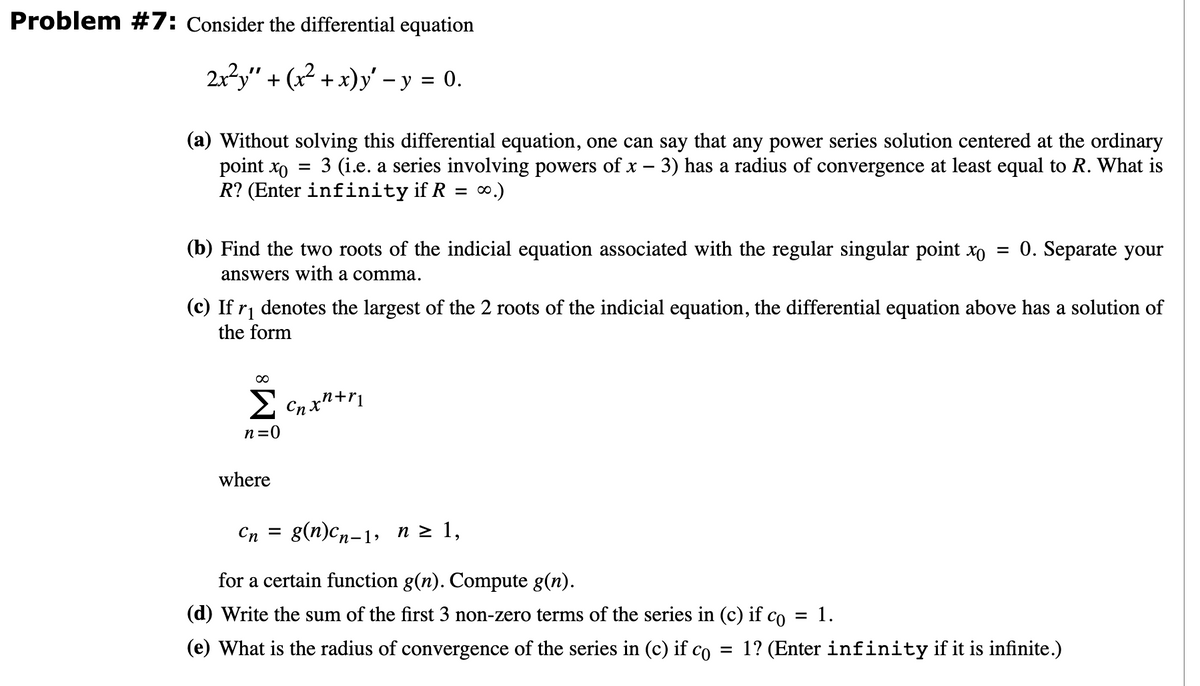Problem #7: Consider the differential equation 2x²y" + (x² + x)y' - y = 0. (a) Without solving this differential equation, one can say that any power series solution centered at the ordinary point xo = 3 (i.e. a series involving powers of x − 3) has a radius of convergence at least equal to R. What is R? (Enter infinity if R = ∞.) (b) Find the two roots of the indicial equation associated with the regular singular point xo = 0. Separate your answers with a comma. (c) If r₁ denotes the largest of the 2 roots of the indicial equation, the differential equation above has a solution of the form ∞ Σ cnxntr n=0 where Cn = g(n)cn-1, n ≥ 1, for a certain function g(n). Compute g(n). (d) Write the sum of the first 3 non-zero terms of the series in (c) if co = 1.
Problem #7: Consider the differential equation 2x²y" + (x² + x)y' - y = 0. (a) Without solving this differential equation, one can say that any power series solution centered at the ordinary point xo = 3 (i.e. a series involving powers of x − 3) has a radius of convergence at least equal to R. What is R? (Enter infinity if R = ∞.) (b) Find the two roots of the indicial equation associated with the regular singular point xo = 0. Separate your answers with a comma. (c) If r₁ denotes the largest of the 2 roots of the indicial equation, the differential equation above has a solution of the form ∞ Σ cnxntr n=0 where Cn = g(n)cn-1, n ≥ 1, for a certain function g(n). Compute g(n). (d) Write the sum of the first 3 non-zero terms of the series in (c) if co = 1.
Advanced Engineering Mathematics
10th Edition
ISBN:9780470458365
Author:Erwin Kreyszig
Publisher:Erwin Kreyszig
Chapter2: Second-order Linear Odes
Section: Chapter Questions
Problem 1RQ
Related questions
Question

Transcribed Image Text:Problem #7: Consider the differential equation
2x²y" + (x² + x)y′ − y = 0.
(a) Without solving this differential equation, one can say that any power series solution centered at the ordinary
3 (i.e. a series involving powers of x − 3) has a radius of convergence at least equal to R. What is
R? (Enter infinity if R = ∞.)
point xo
=
(b) Find the two roots of the indicial equation associated with the regular singular point xo
answers with a comma.
n=0
(c) If r₁ denotes the largest of the 2 roots of the indicial equation, the differential equation above has a solution of
the form
where
Cn
=
Cnxn+r1
=
0. Separate your
g(n)cn-1, n ≥ 1,
for a certain function g(n). Compute g(n).
(d) Write the sum of the first 3 non-zero terms of the series in (c) if co
= 1.
(e) What is the radius of convergence of the series in (c) if co = 1? (Enter infinity if it is infinite.)
Expert Solution
This question has been solved!
Explore an expertly crafted, step-by-step solution for a thorough understanding of key concepts.
Step by step
Solved in 4 steps with 5 images

Follow-up Questions
Read through expert solutions to related follow-up questions below.
Recommended textbooks for you

Advanced Engineering Mathematics
Advanced Math
ISBN:
9780470458365
Author:
Erwin Kreyszig
Publisher:
Wiley, John & Sons, Incorporated

Numerical Methods for Engineers
Advanced Math
ISBN:
9780073397924
Author:
Steven C. Chapra Dr., Raymond P. Canale
Publisher:
McGraw-Hill Education

Introductory Mathematics for Engineering Applicat…
Advanced Math
ISBN:
9781118141809
Author:
Nathan Klingbeil
Publisher:
WILEY

Advanced Engineering Mathematics
Advanced Math
ISBN:
9780470458365
Author:
Erwin Kreyszig
Publisher:
Wiley, John & Sons, Incorporated

Numerical Methods for Engineers
Advanced Math
ISBN:
9780073397924
Author:
Steven C. Chapra Dr., Raymond P. Canale
Publisher:
McGraw-Hill Education

Introductory Mathematics for Engineering Applicat…
Advanced Math
ISBN:
9781118141809
Author:
Nathan Klingbeil
Publisher:
WILEY

Mathematics For Machine Technology
Advanced Math
ISBN:
9781337798310
Author:
Peterson, John.
Publisher:
Cengage Learning,

